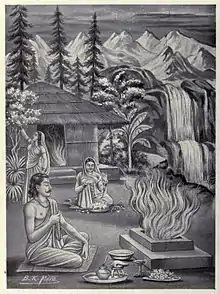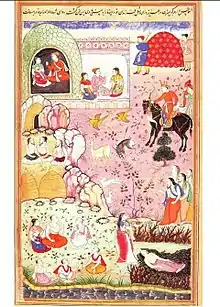Madri
In the ancient Indian epic Mahabharata, Madri or Madhuri was princess of Madra Kingdom who married to Pandu. She had two sons named Nakula and Sahadeva. The word Mādrī means 'she who is the princess of Madra kingdom'.[1]
| Madri | |
|---|---|
| Mahabharata character | |
 Madri, Kunti and Pandu at Shatasrunga hill. | |
| In-universe information | |
| Family | Shalya(brother) |
| Spouse | Pandu |
| Children | Nakula, Sahadeva (sons) Yudhisthira, Bhima, Arjuna (step sons) |
Marriage
Madri was sister of king of Madra Shalya. Once Hastinapur's king Pandu encountered with the army of Shalya. Very soon, Pandu and Shalya became friends. Bhishma then asked Pandu to marry Madri for political reasons. Looking at her beauty, Pandu accepted her and later he married her.[2]
Pandu's curse
While hunting in a forest, Pandu saw a couple of deer in the process of coitus, and shot arrows at them; only to find out that it was a sage named Kindama and his wife who were making love in the form of deer. The dying sage placed a curse on Pandu, that if he would approach his wives with the intent of making love, he would die. Upset and seeking to repent his action, Pandu renounced his kingdom and lived as an ascetic with his wives.[3]
Birth of Nakula and Sahadeva
Due to Pandu's inability to bear children, Kunti had to use the boon given by Sage Durvasa to give birth to her three children's Yudhisthira, Bhima and Arjuna. She shared the boon with Madri, who invoked the Ashwini Kumaras to beget Nakula and Sahadeva.[4]
Death
One day, Pandu was captivated by the beauty of Madri. King Pandu could not resist himself from having embrace her. As a result of Kindama's curse, Pandu died. In grief that her husband died because of her, Madri committed suicide before handing her children to Kunti.[5] It is believed that Mādrī committed sati, in which a woman self immolates on her deceased husband's pyre. However this is believed that this sati was a later addition to the epic.[6]
References
- www.wisdomlib.org (15 June 2012). "Madri, Mādrī, Mādri, Madrī: 14 definitions". www.wisdomlib.org. Retrieved 31 August 2020.
- Debalina (20 December 2019). Into the Myths: A Realistic Approach Towards Mythology and Epic. Partridge Publishing. ISBN 978-1-5437-0576-8.
- Ramankutty, P.V. (1999). Curse as a motif in the Mahābhārata (1. ed.). Delhi: Nag Publishers. ISBN 9788170814320.
- Williams, George Mason (2003). Handbook of Hindu Mythology. ABC-CLIO. ISBN 978-1-57607-106-9.
- Fang, Liaw Yock (2013). A History of Classical Malay Literature. Institute of Southeast Asian. ISBN 978-981-4459-88-4.
- M. A. Mehendale (1 January 2001). Interpolations In The Mahabharata.
| Wikimedia Commons has media related to Madri. |

